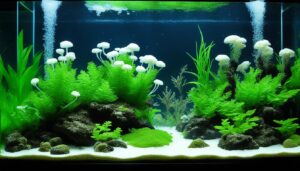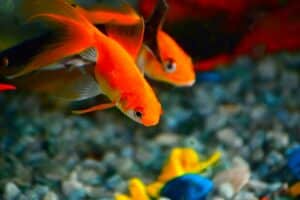As a dedicated fish keeper, I’ve run into my fair share of aquarium challenges. One of the most common—and frustrating—issues is fin rot. This bacterial infection can really take a toll on your fish if left untreated, but the good news is, it’s totally preventable.
There’s nothing better than watching fish like bettas and goldfish glide around the tank, but it’s tough when one gets hit with fin rot. Treating it fast is key. I’ve learned that catching it early can make all the difference and prevent it from becoming fatal.
Fin rot usually comes down to poor water quality or stress. Stress can be caused by overcrowding, rough handling, or even fish fighting. And while fin rot may start off as a cosmetic issue, it’s often a sign of deeper problems in the tank. Keeping the tank clean and not overcrowded is crucial. The general rule I stick to is 1 inch of fish per gallon of water.
From dealing with fin rot firsthand, I’ve realized that keeping fish healthy is about being proactive, not just fixing issues as they pop up. Regular water changes, feeding high-quality food, and not overfeeding make a big difference. And most importantly, keeping a close eye on your fish helps catch any issues before they get serious. Prevention is always better than cure!
Fin Rot Disease in Aquarium Fish
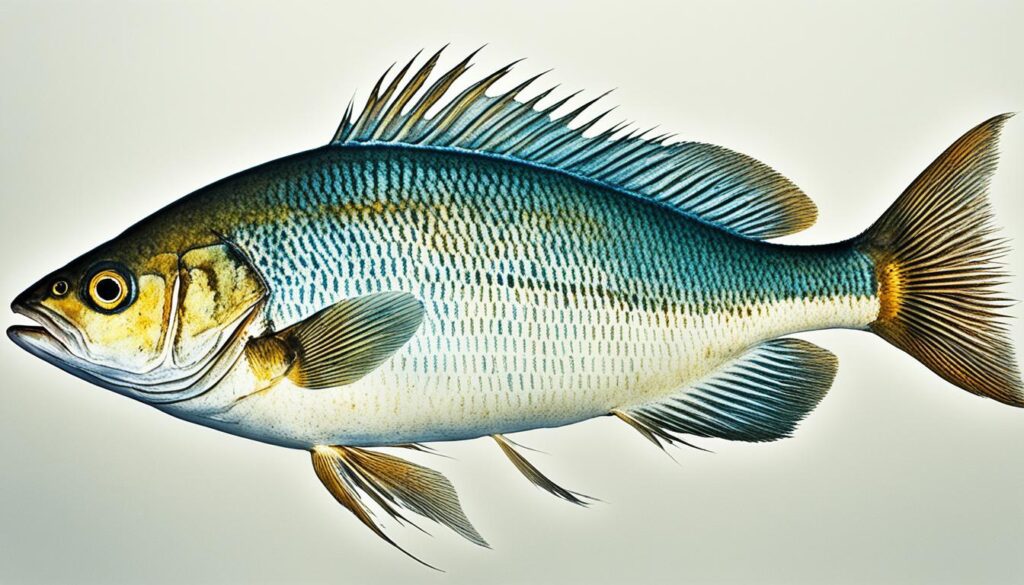
Getting to know fin rot means learning about the symptoms of fin rot, understanding which bacterial pathogens in aquariums can cause it, and knowing which fin rot susceptible species are most at risk. It’s not only a cosmetic issue for fish such as Bettas and Goldfish. It can also seriously harm their health.
Common Symptoms and Identification
Spotting fin rot requires looking for signs that tend to develop in stages. At first, fish may show a little discoloration at their fin edges. This may not seem like a big deal. As it gets worse, their fins look frayed and ragged. In the worst cases, fins and tails can completely rot away, putting the fish at risk of deadly infections. It’s very important to catch these signs early to manage the disease well.
The Role of Bacteria in Fin Rot Development
Fin rot mainly happens because of bacterial pathogens in aquariums which grow in bad water conditions and target fish with weak immune systems. In clean tanks, these bacteria are harmless. But when fish are stressed by things like bad water or bullying, these bacteria attack, hurting the fish’s fins.
Affected Species: From Bettas to Goldfish
Some fish are more likely to get fin rot, especially those with long, pretty fins. This includes Betta fish, Angelfish, and fancy Goldfish. Their lovely but sensitive fins make them more open to fin rot’s damages.
Stage |
Symptoms |
Treatment Recommended |
|---|---|---|
Stage 1 |
Discoloration on fins and tail edges |
Monitor water quality, introduce antibiotics like Erythromycin |
Stage 2 |
Frayed and uneven fin edges |
Addition of aquarium salt |
Stage 3 |
Complete rotting of fins, potential body infection |
Intensive treatment with combined antibiotics and frequent water changes |
As lovers of fish, we must learn about and fight diseases like fin rot. With careful attention, watching our tanks, and acting quickly, we can keep our fish healthy and happy.
Primary Causes of Fin Rot Disease
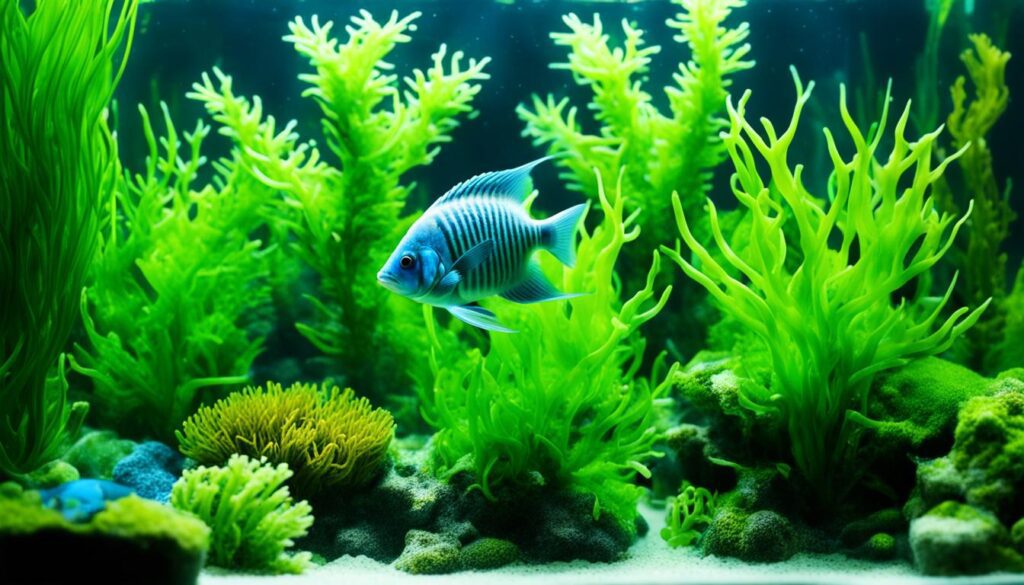
Knowing the main reasons for fin rot disease is key for fish lovers and tank owners. This harmful condition mostly comes from aquarium disease causes like bad aquarium water quality. Poor water is often the start of many stress factors for fish.
Poor water conditions are a big stress reason in fin rot. Keep ammonia, nitrites, and nitrates at the right levels. Their ups and downs can weaken a fish’s immune system. Cold water and too many fish in a tank are also issues. Checking and keeping water quality good can stop these problems.
Also, injuries and aggression among fish make fin rot worse. Fights can lead to fin damage, creating openings for bacteria and fungus. A big, enriching home for fish lowers stress and fighting. This can lessen injuries.
Here are some important tips for a healthy tank:
- Test water often to watch and change ammonia, nitrite, and nitrate levels.
- Keep water temperatures right for your fish type.
- Have a regular cleaning plan to stop bad substances from building up.
- Use tank décor carefully to avoid injuries.
- Watch for signs of too much aggression or stress in fish.
It’s also vital to think about the plants and animals you add to the tank. Adding live plants, for example, can help handle waste, making aquarium water quality better.
Condition |
Cause |
Prevention Method |
|---|---|---|
High Ammonia Levels |
Poor filtration, Overfeeding |
Regular filter maintenance, Controlled feeding |
Aggression |
Overcrowding, Mixed species incompatible |
Spacious tank, Species-specific tanks |
Temperature Fluctuations |
Inadequate heating, Environmental changes |
Install submersible heaters, Regular temperature checks |
To view the effect of these issues visually, look at the common signs in sick aquariums:
Using these methods helps prevent fin rot and keeps your aquatic pets healthy. Being proactive with these aquarium disease causes means a happy tank free from fin rot.
Diagnosing Fin Rot in Your Aquatic Pets
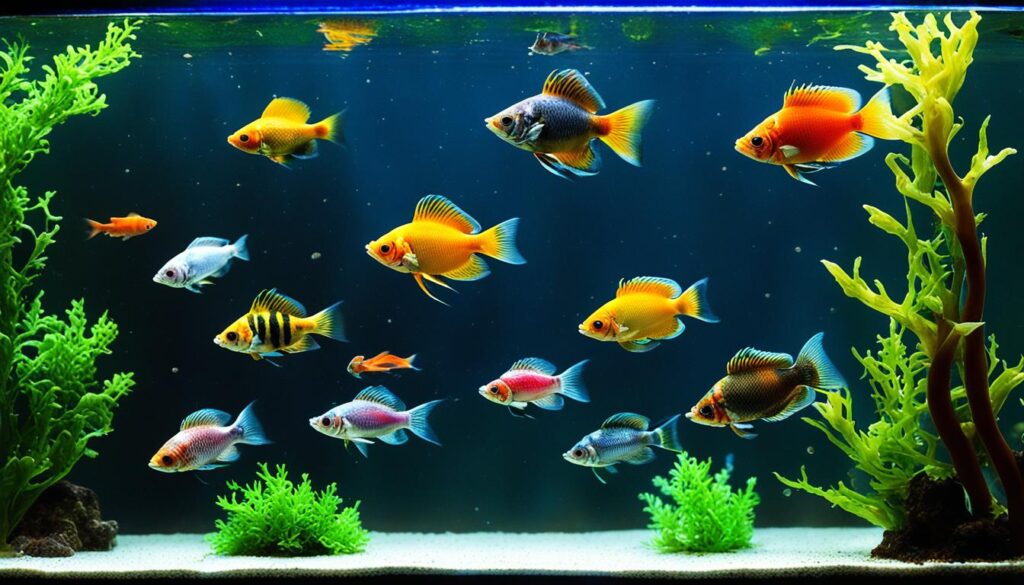
Keeping aquarium fish healthy means watching for fin rot early. Knowing the signs of fin rot symptoms means you can help your fish quickly. Learn what to look for and when to get help from a fish vet.
Signs to Look For
Spotting early fin rot signs is key but can be tricky. Fish might start with their fins turning a different color. Then, their tails or fins might look torn.
A clear sign is a white, fuzzy growth on their fins edges. There might also be redness or swelling near the fins. If your tank isn’t clean or the fish is stressed, these signs can show up fast. This gives you a chance to act quickly.
When to Consult an Aquatic Veterinarian
Seeing things like torn fins or a fish not moving much means it’s time to think about seeing a fish vet. If things don’t get better with your first fixes, like cleaning the tank, a vet visit is key. They can test the water and maybe even the fish’s tissues.
This way, you’ll know exactly what’s wrong. And you’ll get a treatment plan that’s just right for your fish.
Symptom |
Common Causes |
Preventive Measures |
|---|---|---|
Frayed, discolored fins |
Poor water quality, bacterial infection |
Regular water changes, maintaining optimal tank conditions |
White cottony growth on fins |
Fungal infections secondary to fin rot |
Use of antifungal treatments like Methylene Blue |
Behavioral changes (e.g., lethargy) |
Stress due to overcrowding, improper tank mates |
Monitor fish compatibility, ensure spacious tank environment |
Loss of fins, redness at base |
Progression of fin rot, severe bacterial attack |
Immediate antibiotic treatment, consult aquatic veterinarian |
Knowing these signs and getting an expert’s help in bad cases keeps your fish safe. This ensures they live long, healthy lives.
Effective Treatment Options for Fin Rot
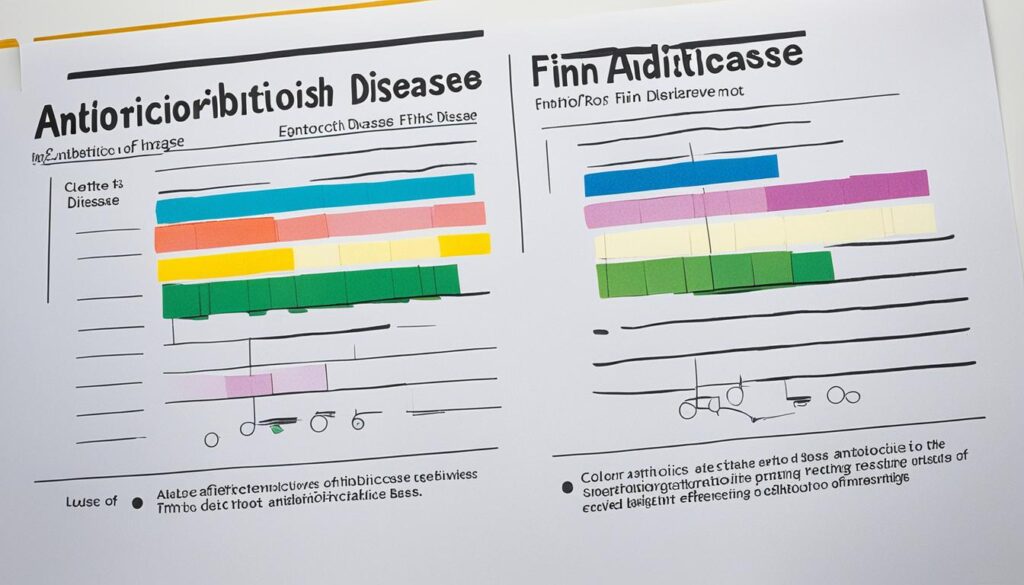
Looking at fin rot in aquarium fish, both quick and ongoing plans are key. This means using special antibiotics and taking great care of the tank’s water. We’ll dive into how to address this ailment, usually due to harmful bacteria.
Antibiotic Treatments and Water Quality Management
Since fin rot is tough, specific antibiotics are needed for the harmful bacteria. Drugs like Erythromycin or Kanaplex are good choices. But treatment isn’t just about meds. Good water quality is also crucial in fighting and preventing fin rot. Changing the water often, treating it right, and keeping it at 80-82°F are important.
Daily checks on water conditions and keeping it clean are key. This makes a better home for fish and keeps them healthy and disease-free.
Importance of Completing Antibiotic Courses
It’s vital to use all the antibiotic doses without missing any. Stopping too soon can bring the disease back. During treatment, take out carbon filters from the tank. They can soak up the medicine, making it less effective.
Finishing the whole antibiotic treatment and following up care can really help. It raises the chances of curing fin rot and stops it from coming back.
Treatment Type |
Recommended Dosage |
Duration |
|---|---|---|
Erythromycin |
Consult package for specific dosages |
Up to 10 days |
Kanaplex |
Refer to manufacturer’s guidelines |
5-7 days with observations |
Water Changes |
25% daily |
Continue until recovery |
Aquarium Salt |
1 tbsp per 5 gallons |
Use as preventative measure |
Mixing the right medical treatments with great water care helps fight fin rot. This way, fish keepers can have healthier aquariums.
Preventative Measures to Protect Against Fin Rot Disease
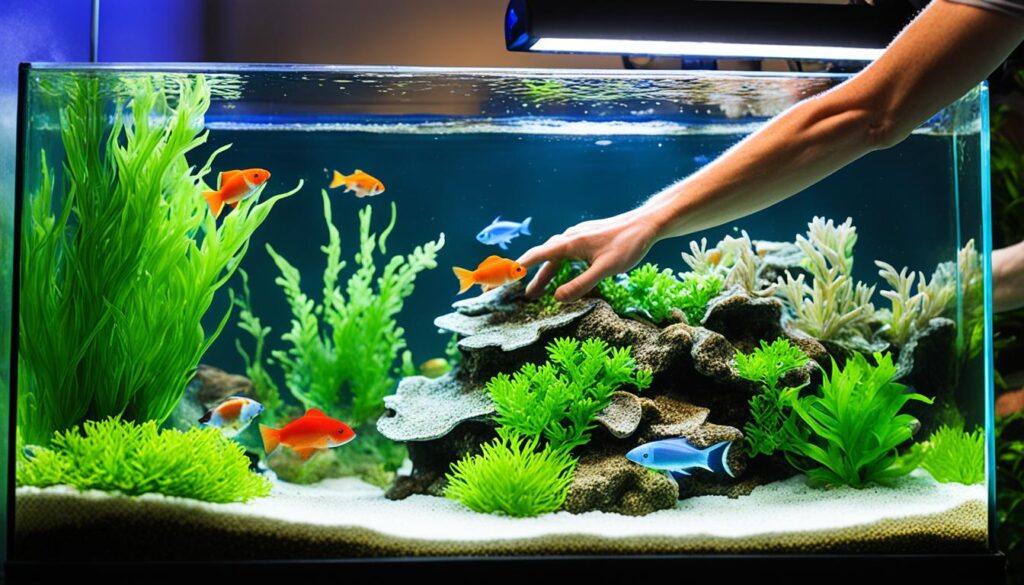
To keep an aquarium healthy, stopping fin rot is crucial. It means sticking to top-notch fish tank maintenance. Proper water quality monitoring and a healthy aquarium ecosystem are must-dos. Good water and cleanliness lower fin rot risks a lot.
For those looking to keep fin rot at bay, here’s a simple guide to follow:
- Monitor Water Quality Religiously: Check pH, ammonia, nitrites, and nitrates often. Aim for a pH of 7-8, no ammonia, and low nitrites and nitrates. Use a reliable test kit each week.
- Regular Water Changes: Change half the water weekly if your tank is cycled. Adjust based on tank size and number of fish. This removes toxins and keeps the tank clean.
- Avoid Overcrowding: Too many fish can stress them out, raising the risk of fin rot. Follow the rule of 1 inch of fish per 2 gallons of water.
- Feeding Practices: Don’t overfeed to avoid bad water quality and more waste. Feed fish what they can eat in five minutes with quality food to boost their health.
These steps will help prevent fin rot and boost your aquarium ecosystem’s health. Clean, well-cared-for tanks stop harmful germs from causing fin rot.
A well-maintained tank is your best shield against fin rot. Regular care stops disease and promotes a lively aquatic scene. Check regularly for stress, sickness, and water issues. Quick action and careful upkeep are vital for a thriving tank. Stay alert to keep your fish happy and healthy.
Proper Tank Management to Prevent Disease

In my years of managing aquariums, I’ve learned a lot about fighting diseases like fin rot. It’s all about keeping an environment that supports the fish’s health. Effective aquarium management is about balancing water condition optimization and dietary support for fish. This approach helps prevent fin rot in aquariums and improves the health of all the fish.
Maintaining Optimal Water Conditions
Happy fish need great water quality. It’s crucial to regularly check the tank’s water for pH, temperature, ammonia, nitrite, and nitrate levels. Keeping these parameters stable prevents many diseases.
For newbies, here’s what I look at in my routine checks:
Parameter |
Optimal Range |
Tools for Measurement |
Regular Check Frequency |
|---|---|---|---|
pH Level |
6.5-7.5 |
pH Meter |
Weekly |
Temperature |
78-82°F |
Thermometer |
Daily |
Ammonia |
0 ppm |
Test Kit |
Bi-weekly |
Nitrite |
0 ppm |
Test Kit |
Bi-weekly |
Nitrate |
Test Kit |
Monthly |
Feeding Practices and Nutrition for Immune Support
Great water quality and the right food are key. Giving fish a balanced diet makes them stronger against diseases like fin rot. I use high-quality food that meets each fish’s needs without overfeeding. This keeps the tank clean.
I have a feeding routine that includes:
- Feeding small portions twice a day
- Offering different kinds of food (flakes, pellets, frozen food)
- Making sure all fish can eat during feeding times
- Watching the fish eat to check their health and energy
By focusing on water quality and the right food, I’ve made my aquarium thrive and lowered sickness. With the right care, our fishy friends can enjoy a vibrant and healthy home.
Natural Remedies and Care for Fin Rot
Battling fin rot in fish like bettas and goldfish often needs both medicine and natural treatments. This combo helps support your fish’s healing much like good food and a healthy environment helps us recover. A popular natural remedy among fish owners is using aquarium salt. But, remember to use the correct type of salt and dose it right for freshwater tanks. Also, tweaking the water temperature a bit can encourage healing. These natural remedies are especially effective in the early stages of fin rot.
Good water quality is crucial for recovering fish. Signs like frayed fins and redness mean it’s time to check and improve your water. Regularly changing 25%-33% of the tank’s water and watching the pH, temperature, and ammonia levels helps. In my 75-gallon tank, my colorful fish community thrives, showing off their energy and appetite as they recover.
Having a great filtration system is key too. In my aquarium, I use two filters that clean 580 gallons per hour, helping prevent fin rot from coming back. Combining careful maintenance with the right medication and isolating sick fish increases their recovery chances. Always watch your fish closely, especially during feeding times. This can help you catch fin rot early on.

